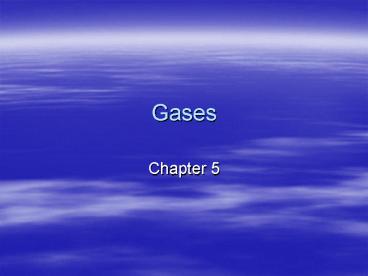Gases - PowerPoint PPT Presentation
1 / 16
Title:
Gases
Description:
Theory is based on the idea that all gases behave similarly as far as particle ... John Dalton 1801 The total pressure of a gas mixture is the sum of the partial ... – PowerPoint PPT presentation
Number of Views:60
Avg rating:3.0/5.0
Title: Gases
1
Gases
- Chapter 5
2
Kinetic Theory of Gases
- Developed between 1850-1880 by James Maxwell,
Rudolf Clausius, Ludwig Boltzman, and others. - Theory is based on the idea that all gases behave
similarly as far as particle motion is concerned.
3
Kinetic Theory of Gases
- To completely describe the state of a gaseous
substance the following must be specified - Volume
- Amount
- Temperature
- Pressure
4
Kinetic Theory of Gases
- Postulates
- All gases consist of particles (atoms, molecules)
in continuous random motion. - Collisions between gas molecules are elastic.
Total energy is constant. - The volume occupied by the particles is small
compared to container. - Attractive forces between particles have a
negligible effect on their behaviors, act as
independent particles. - Et cT, Kinetic energy is directly proportional
to temperature. At a given T all gases have the
same KE (Et or translational energy).
5
Ideal Gas Law
- PV nRT
- The Ideal Gas Law can be manipulated depending on
your conditions.
6
Ideal Gas Law at constant V
- P1V nRT1 P2V nRT2
- P1 nR P2 nR
- T1 V T2 V
- Therefore P1 P2
- T1 T2
7
Ideal Gas Law at constant P
- PV1 nRT1 PV2 nRT2
- V1 nR V2 nR
- T1 P T2 P
- Therefore V1 V2
- T1 T2
- Charles Law
8
Ideal Gas Law at constant T
- P1V1 nRT P2V2 nRT
- Therefore P1V1 P2V2
- Boyles Law
9
Law of Combining Volumes
- Gay-Lussac, 1808
- The volumes of different gases involved in a
reaction, if measured at the same temperature and
pressure, are in the same ratio as the
coefficients in the balanced equation.
10
Partial Pressure and Mole Fraction
- John Dalton 1801 The total pressure of a gas
mixture is the sum of the partial pressures of
the components of the mixture. - PTotal PA PB PC
- Partial pressures may be found by using the ideal
gas law PV nRT
11
Partial Pressure and Mole Fraction
- PA nA x RT/ V PTotal nTotal x RT/ V
- Dividing PA by PTotal
- PA/PTotal nA/ nTotal or PA nA/nTotal x
PTotal - The fraction of nA/ nTotal is called the mole
fraction of A in the mixture. The symbol used
for mole fraction is X. - Therefore PA XA PTotal or the partial pressure
of a gas in a mixture is equal to its mole
fraction multiplied by the total pressure.
12
- Grahams Law
- Average Speed of Gas Particles
- Real Gases
- Van Der Waals Equation
13
Average speeds (u) of Gas Particles
- u (3RT/ M)1/2 M Molar mass
- From this we can see average speed is directly
proportional to the square root of the absolute
temperature - u2/ u1 (T2/ T1)1/2
- From this we can see average speed is indirectly
proportional to the square root of molar mass (M) - uB/ uA (MA/ MB)1/2
14
Diffusion and Effusion of Gases Grahams Law
- Thomas Graham, 1829
- Diffusion refers to the movement of gas particles
through space, from a region of high
concentration to one of low concentration. - Effusion is the flow of gas particles through
tiny pores or pinholes. - Effusion depends on two factors
- The concentration
- The relative velocity of the particle
15
Diffusion and Effusion of Gases Grahams Law
- If two different gases A and B are compared at
the same pressure, only their speeds are of
concern, and - rate of effusion B uB/ uA
- rate of effusion A
- So, at constant pressure and constant
temperature, - rate of effusion B (MA/ MB)1/2
- rate of effusion A
16
Real Gases
- All real gases deviate slightly from the ideal
gas law. This occurs largely at - high pressures
- low temperatures.
- From a molecular standpoint these deviations are
due in part to - Attractive forces between gas particles
- The finite volume of gas particles































